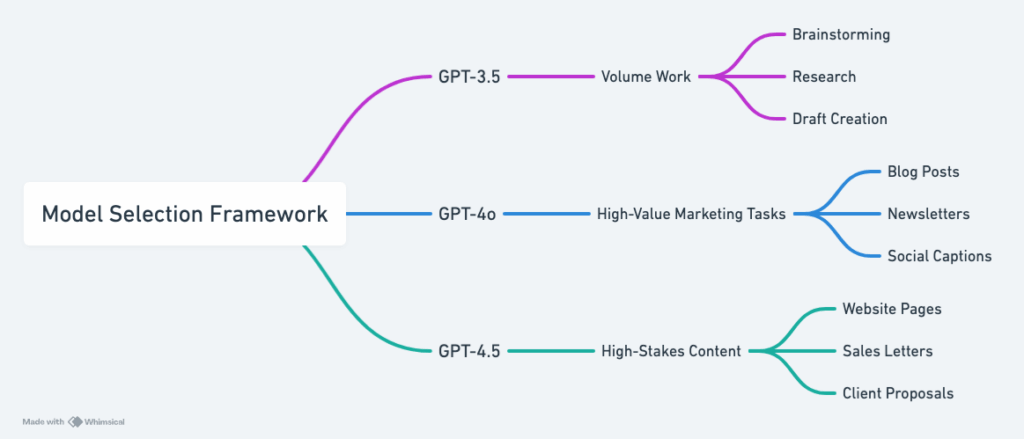Your cart is currently empty!

Stop Spinning – ChatGPT Models Comparison for Business Growth
Reading Time: 8 minutesYou’re drowning in AI options, aren’t you?
When OpenAI released GPT-4o, the noise level in the AI world spiked—again. And for good reason. The model is fast, affordable, and built with a multi-modal future in mind. But here’s the problem: most of the content floating around about ChatGPT models is written for developers, not decision-makers.
If you’re a business owner using AI to scale your marketing or operations, you don’t need token limits; you need clarity. Which model gives you the most leverage for your specific goals? That’s what this post delivers. A plain-English ChatGPT models comparison, written for business growth.
Which ChatGPT Model Is Right for You?
Let’s make this simple. Below is a side-by-side ChatGPT model comparison designed for business use. No jargon, just the insights that matter:
- What each model does best
- Where the trade-offs are (speed, tone, cost)
- How to pick the right one for the job
Think of this as your decision support table, so you can spend less time guessing and more time implementing.
ChatGPT Models Comparison: Speed, Quality, and Value
| Model | Speed | Output Quality | Cost | Best Use Case |
|---|---|---|---|---|
| GPT‑3.5 | Fastest | Decent for basic tasks | Free & included | Marketing copy, summaries, and idea generation |
| GPT‑4o | Fast + Smart | Strong reasoning, good writing tone | Included in Plus | Marketing copy, summaries, idea generation |
| GPT‑4.5 | Slower but Rich | Most nuanced and polished output | Paid tier (Pro) | Quick drafts, outlines, and non-critical content |
In the rest of this short post, I’ll give you the information a business decision maker needs to pick the right model for their marketing tasks.
The Real Problem with AI Model Selection
“I tried ChatGPT for my website copy, but it sounded so robotic.”
Sound familiar? The issue isn’t ChatGPT – it’s model mismatch. You’re using a chef’s knife when you need a scalpel. (It could also be your prompt. There’s more on this below. And for help choosing the right prompt framework, read our post: 5 AI Prompt Frameworks for Marketing.)
Think of ChatGPT models like your marketing team. You wouldn’t ask your junior copywriter to handle your most important client presentation, right? The same principle applies here.
The Three Models That Actually Move the Needle

In plain language, here are the three ChatGPT models you will use for most of your business needs. (Follow the link to see all of OpenAI’s models.) You still need to choose the right one, but selecting from three is a whole lot easier than sorting through the 10 models available as of May 2025.
GPT‑3.5: Fast and Free, But Limited for Complex Tasks
When to use: Volume activities like social media ideas, subject line testing, quick drafts, and keyword research.
Fast, cheap, and perfect for high-volume work. Use this when you need 20 headline options or want to explore different angles quickly. It’s not polished, but its emphasis on the ‘performance’ in model performance is perfect for getting unstuck.
Think of GPT-3.5 as your virtual brainstorming team.
GPT-3.5 is your workhorse. It plows the fields efficiently and in straight lines without costing much. It’s a great choice for light usage, but usage limits start to show with more complex or nuanced tasks.
Looking for ways to push the boundaries with advanced use cases? You’ll want to check out these power-user prompting secrets and AI tips that actually move the needle.
GPT‑4o: Balanced Speed and Smarts for Everyday Use
When to use: 4o’s balanced model performance is ideal for high-quality activities like website copy, email campaigns, blog posts, and client proposals. It hits the sweet spot in the latency vs speed trade-off.
This is your go-to model for professional marketing content. It’s like having a skilled marketing manager on your team who is reliable, consistent, and professional enough for customer-facing materials.
GPT-4o is your riding horse because it balances abilities with cost. It’s the perfect choice for high-value content because it delivers quality without the premium price tag. Your customers won’t know the difference between this and more expensive options.
If you’re new to ChatGPT, this beginner’s guide walks through the basics of how to use the tool well, before you start swapping models.
GPT‑4.5: Highest Quality Output When Nuance Matters (Pro Only*)
When to use: Brand messaging, high-stakes copy, strategic content
For high-stakes content, you need the best. GPT-4.5 understands nuance, tone, and context better than any other model. If you’re crafting your unique selling proposition or writing copy for a $50K proposal, this is your weapon of choice. The pricing differences between GPT‑4o and GPT‑4.5 reflect their use cases.
GPT-4.5 is your racehorse; it has a higher cost, but delivers amazing results. You don’t use it for laps around the pasture; you bring it out when the stakes are high and the finish line matters. GPT-4.5 provides precision that justifies its price tag.
GPT‑4.5 shines when nuance matters. It’s especially useful for brand messaging, customer communication, and complex writing. If that’s your use case, you’ll want to read how to make AI copywriting sound like you.
* You’ll need ChatGPT Pro ($20 per month) to access this model.
This section compares the top three ChatGPT models from the perspective of a business decision maker. And while model selection is important, the following section will give you context on how to use the models (prompting) and when and where to apply them.
How Prompting Affects Each Model’s Output
(And Why This Changes Everything)
Your prompt isn’t just instructions, it’s soft fine-tuning in real time. Think of it like giving directions to three different drivers: one who needs a GPS with every turn called out, another who can follow a general route, and the third just needs to know the destination.
The pattern is simple: better models pick up on subtler cues. The same exact prompt will generate completely different results across GPT-3.5, GPT-4o, and GPT-4.5.
Here’s how each model “listens”:
GPT-3.5 needs everything spelled out. Vague prompts get vague responses. It’s like working with a bright intern who’s eager to help but constantly asks, “What exactly do you want me to do here?” Fast and cheap, but easily confused without context.
GPT-4o reads between the lines. It catches tone, follows formatting cues, and responds to subtle guidance like “write this conversationally” or “make it sound authoritative.” Perfect for marketing copy, client communications, or any task where nuance matters.
GPT-4.5 is the mind reader. It captures emotional undertones, strategic layers, and even picks up on brand voice from minimal examples. If your prompt includes complex reasoning or sophisticated guidelines, this model actually honors them.
You can guide the models to much better output with smarter prompts, and the return on that effort scales directly with model quality.

Pro Tip
💡 Want to go deeper? These advanced prompting secrets show you how to get better results without writing longer prompts.
The business owner using GPT-3.5 for everything? They’re leaving money on the table. On the other hand, those who match their prompts to the right model are achieving enterprise-level results at a fraction of the cost.
Which ChatGPT Model Should You Use? A Strategic Comparison
Here’s our cheat sheet that matches models to tasks:

Volume Work (Brainstorming, research, draft creation) → Use GPT-3.5
High-Value Marketing Tasks (Blog posts, newsletters, social captions) → Use GPT-4o
High-Stakes Content (Website pages, sales letters, client proposals) → Use GPT-4.5
Real-World Impact: One of our clients was spending 3 hours writing a single newsletter using GPT-4.5. When we switched them to GPT-4o for this mid-funnel content, they got the same quality in just 45 minutes, saving 2+ hours per week while reducing AI costs by 60%.
Match Your AI Model to Your Marketing Task
We advocate aligning your marketing against the buyer’s journey. This means you need to fine-tune the content you’re creating based on who you’re trying to attract and where they are in their journey.
Get the right message to the right person at the right time. ~ Direct Marketing axiom
The same principle applies to the selection of AI models. Don’t use the same model for everything.
Top of Funnel (Attraction): Your prospects don’t know you exist yet. They need high-volume, problem-focused content that gets them to notice you. GPT-3.5 is perfect here. With it, you can quickly generate dozens of social posts, blog topics, and attention-grabbing headlines.
Middle of Funnel (Engagement): Now they’re paying attention, but they’re not ready to buy. They need nurturing content that builds trust and demonstrates expertise. GPT-4o excels at creating email sequences, targeted ad copy, and educational content that supports the buyer’s journey and moves prospects closer to a decision.
Bottom of Funnel (Conversion): This is where precision matters most. You need content that attracts the right prospects while repelling the wrong ones. An assessment survey or qualification tool created with GPT-4.5 will ask the right questions in the right way, identifying serious buyers while saving you from tire-kickers.
The result? Each model serves a specific purpose in moving prospects from strangers to customers because your content matches what they need at each stage of their journey.
“If you only have a hammer, you tend to see every problem as a nail.” ~ Abraham Maslow
Already using ChatGPT and want to squeeze even more value out of it? These 16 advanced ChatGPT tips show you how to get better results with less trial and error.
Don’t Make This Expensive Mistake
Here’s a $200/month mistake I see when business owners default to the most expensive model for everything, assuming it’s always better.
The math doesn’t work. If you’re using GPT-4.5 for social media brainstorming, you’re paying 5x more per task than necessary. Over a month, that’s the difference between a $40 AI bill and a $200 AI bill, with zero improvement in results.
Using GPT-4.5 for social media brainstorming is like hiring a brain surgeon to check your temperature.
Quick Model Matching Guide
| Task Type | Best Model |
|---|---|
| Keyword research | GPT-3.5 |
| Blog outline | GPT-4o |
| Social post ideas | GPT-3.5 |
| Writing Custom Instructions | GPT-4.5 |
| Drafting a client proposal | GPT-4o |
| Refining a client proposal | GPT-4.5 |
| Reviewing prompt tone | GPT-4.5 |
| Writing 20 subject lines | GPT-3.5 |
I used GPT-3.5 to do keyword research for this blog post. Then I used GPT-4o to prepare an outline. When the first draft was complete, I asked GPT-4.5, posing as an editor, to review the draft and suggest improvements.
Don’t pay premium prices for capabilities you don’t need. Use the right tool for the job. That’s how you maximize ROI on your AI investment.
Real-World Application: Transforming Email Marketing with Strategic AI
Want to see this model selection strategy in action?
We’re currently taking the approach described in this post to level up a client’s email marketing.
The Challenge: Their email open rates look great, but sales aren’t following. Sound familiar? The high open rates suggest that the problem isn’t their subject lines. Our hypothesis is that their segmentation strategy and the corresponding messaging strategy are the problem.
Our Solution:
- GPT-4o for Analysis: We’re using it to cross-analyze customer purchase behavior, email engagement patterns, and behavioral characteristics taken from MailChimp and their store data. This reveals which subscribers make purchases and who simply browse.
- GPT-4.5 for Strategic Messaging: Based on these behavioral insights, we’re crafting segment-specific email content that speaks differently to high-value customers, at-risk buyers, and bargain hunters.
Early Results: We’re seeing dramatic improvements in email-driven revenue by matching the right message to the right customer segment. We can do this by using the right model for each task.
The analytical heavy lifting is done efficiently with GPT-4o, while GPT-4.5 creates nuanced, psychologically informed copy that converts.
Stay tuned for the full case study, complete with results and step-by-step implementation details.
ChatGPT Models Comparison
Start Getting Better Results with the Right Model
Bottom Line for Business Owners:
- GPT-3.5 = High volume, low cost (perfect for ideation)
- GPT-4o = Professional quality at reasonable cost (your daily workhorse)
- GPT-4.5 = Premium results for premium situations (when stakes are high)
Pick one piece of marketing content you’re working on this week. Match it to the right model using the framework above.
Notice how much better your results are when you’re not fighting against the tool?
That’s the power of strategic AI implementation. Less confusion, better results, more time to focus on growing your business.
Are you ready to stop wasting time and money on AI guesswork?
Contact me to discuss how your business can build marketing systems that generate predictable revenue growth.
Related Posts
-
Advanced Prompting Secrets
Three ways to level up your conversations with AI and maximize its value.
-
12 AI Hacks That Move the Needle
Learn how Process beats tools and use AI to create value not frustration.
-
Use the ChatGPT Model That Matters
Compare top ChatGPT models for speed, cost, and output quality. A guide for business owners.
Author: James Hipkin
Since 2010, James Hipkin has built his clients’ businesses with digital marketing. Today, James is passionate about websites and helping the rest of us understand online marketing. His customers value his jargon-free, common-sense approach. “James explains the ins and outs of digital marketing in ways that make sense.”
Use this link to book a meeting time with James.

